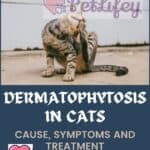
Mastocytoma in cats is less common than in dogs and, in general, less aggressive. Let’s see the cause, symptoms and treatment of this pathology.
Mast cell tumor in cats can occur anywhere on the animal’s body, but is more common in parts such as the skin of the head or neck. Cats affected by these tumors are generally middle-aged and even older, but it must be said that it is quite common for a cat to come out of this condition in the best conditions, including small kittens.
In fact, the skin lesions caused by mast cells are often benign in cats. In some cases, surgery isn’t necessary because the problem clears up on its own. The breed most prone to this problem seems to be the Siamese, they develop a specific type of tumor called histiocytic mast cell tumor.
Cause of mast cell tumor in cats
Mastocytoma in cats, is one of the tumors not particularly frequent in felines, fortunately. Cases of mast cell tumors in cats account for about 3% of reported neoplasms, usually involving middle-aged or elderly cats. The average age of felines diagnosed with mast cell tumors is 10 years and they are usually FeLV negative.
Mastocytoma in cats differs from mast cell tumors in dogs, because in the feline case, the tumor can occur both in cutaneous and visceral form, even the two forms can also be present at the same time.
- The cutaneous form of mast cell tumor in cats is characterized by the presence of nodules that can be in any part of the body even if there are areas that are more prone to this type of tumor and are the head and neck.
- The visceral form causes problems both at the blood level and at the level of the gastrointestinal tract but we can also speak of mast cell tumor in the systemic cat if the blood and lymphatic vessels are involved, therefore blood, spleen, liver and bone marrow. This form has a poor prognosis and is associated with clinical signs such as vomiting, weight loss, and loss of appetite.
Symptoms of mast cell tumor in cats
The symptoms of mastocytoma in cats are a bit misleading, it is very easy to associate them with other diseases as well, as they are not so different, but if the mastocytoma in the skin can also be visible, if we speak instead of the visceral one to be recognized it will be necessary to evaluate the symptoms. These are the main symptoms that the cat accuses:
- anorexia;
- He retched;
- cat diarrhea;
- presence of masses in the abdomen.
Mast cell tumors can vary from day to day, depending on the degree of inflammation generated by the degranulation of the cells.
Diagnosis and treatment

Mast cell tumor in cats can be accurately diagnosed simply by subjecting the cat to a needle aspiration, but in some cases, this may not be enough and an advanced cytological examination, such as immunohistochemistry, will be required at the time of histopathological evaluation.
The grade of the tumor that determines the general prognosis of the animal can only be assessed after performing a surgical biopsy and histopathological analysis of the tumor. Once removed, the tumor is sent for histopathology.
Your vet may recommend additional staging tests, such as an ultrasound of the abdomen and / or chest X-rays, to determine if there are any signs of malignant cancer cells and to check for metastases at the time of diagnosis.
In particular, abdominal ultrasound is used to evaluate the raw size, shape and texture of the abdominal organs. For the treatment of mast cell tumor in cats, the first thing to do after the ascertained diagnosis is to intervene surgically to be able to totally eliminate the tumor cells. The removed tumor will be sent to histopathology, to obtain confirmation of the type and stage of the tumor.
Once this information has been determined, the veterinarian specializing in these particular oncological diseases will establish the appropriate treatment to be able to proceed with the care of the cat, through the use of radiation and chemotherapy after surgery. Specifically, we explain what it all consists of.
Surgery
In the presence of cancer, surgery is the first form of treatment for the sick cat, as it eliminates the malignant mass present in the cat’s body. The veterinarian will decide whether it is useful to proceed with the total elimination or proceed with the partial assisted by chemotherapy or radiotherapy.
Radiotherapy
Radiotherapy consists of external radiation towards cancer cells, with the aim of killing them but unfortunately it also destroys healthy cells. The treatment lasts from 3 to 5 weeks. The most frequent side effects are cat vomiting, nausea, hair loss and skin irritation, which can be controlled with the use of medications.
Chemotherapy
Chemotherapy are drugs used to kill diseased cells from the body. Unfortunately, chemotherapy drugs do not know how to differentiate benign from diseased cells, and this is precisely the reason why hair falls out in people undergoing chemotherapy.
Furthermore, it is not always able to cure cat cancer, but it can slow down its progression and improve its quality of life. There are different types of chemotherapy drugs that can be used based on the type of cancer the cat has developed. Chemotherapy is typically used in conjunction with surgery and / or radiation therapy.
So the first thing will be the surgery followed by the radiotherapy sessions and finally the chemotherapy. As for the latter, this type of treatment must be used in the case of the cat, only if the disease has spread to other organs or we are talking about high-grade tumors.
For the prognosis it will be borne in mind that lower grade tumors have longer survival times and higher grade tumors have shorter survival times. Additional prognostic factors include breed, clinical presentation, tumor location in the cat, staging results, and surgical margins.






